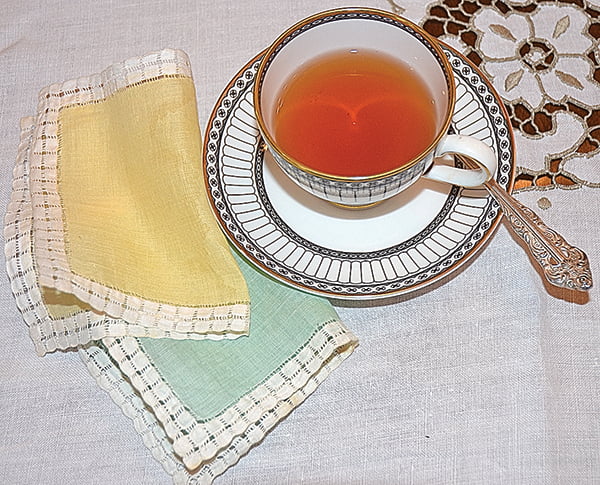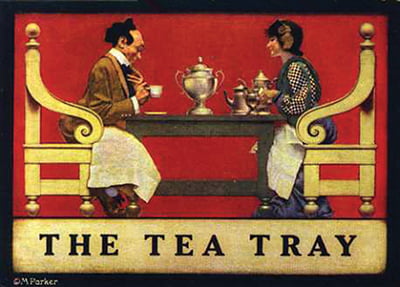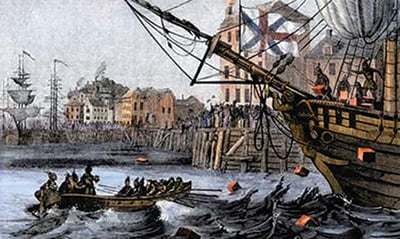
We may drink tea out of mugs and on the run most days, but it’s nice to “put on the dog,” bring out the china and crystal and lay a fancy table for company. Setting a table for tea reminds us of why our ancestors thought so much of this ritual. A strawberry cake served on Lenox and Wedgwood china beside dainty handmade napkins, tastes wonderful paired with a simple black tea poured from a Friendly Village tea pot. Whether it’s brewed the “real” way – from loose tea – or from tea bags, tea always hits the spot. Add a spoonful of sugar and a dash of milk and you have the real nectar of the gods. Historical, traditional and sensually appealing – the tea table is an example of hospitality at its finest.
Laura Dean Bennett
Staff Writer
Before and during the American Revolution, many tavern signs were made with a political statement in mind, but the whimsical sign of the The Tea Kettle and Tabby Cat in Wenham, Massachusetts, seems innocent enough, unless one believes that 18th century cats were secretly on the side of the rebels.
No matter what the occasion – welcoming company, a persistent chill, a terrible fright, good news or bad – a hot cup of tea is just the thing to make everything better.
These days, we usually serve our tea in big mugs and, more often than not, we even brew it in the microwave. Quelle horreur!
But once upon a time, not so long ago, we drank our tea out of a fragile china cup set inside a dainty saucer.
Ah, the good old days!
That’s when tea kettles whistled on the back of the stove, and tea was brewed in a tea pot.
Most homes had an “everyday” tea pot and some had a fancy one “for company.”
We originally got the idea to pour tea from decorative tea pots – and the tea itself – from China.
And no matter how tastes and styles have changed over the centuries, tea, the “China drink,” has remained the most universally popular beverage around the world – with coffee being a close second.
Besides being a necessary start to every morning, an unfailing conversation starter and a meaningful social ritual in some cultures, tea has a rich history.
The tea trade opened up commerce between Asia and Europe and made countless men rich.
And in the history of the American colonies and, later, the upstart new nation that they formed, tea played a starring role.
Many historians agree that a Dutch trader named Peter Stuyvesant brought the first tea to America.
He began supplying colonists in the Dutch settlement of New Amsterdam (later re-named New York by the English) in 1650.
The Dutch, like the English, were confirmed tea drinkers.
Years later, when they acquired the colony, the English discovered that the small colony of New Amsterdam actually consumed more tea at that time then all of England put together.
A few privileged English colonists in Boston were brought tea by visitors from England beginning in 1670, but it was not available for sale to the public until 20 years later.


Special gathering places called “tea gardens” were opened around the natural springs in New York City.
The city fathers had equipped the springs with pumps to facilitate the tea craze and many people started calling the tea gardens, “tea springs.”
By 1720, tea was a primary, and lucrative source of trade between England and her American colonies.
The tea trade was heaviest in Boston, New York and Philadelphia, future centers of the American rebellion.
Like most of his fellow colonists, Dr. Samuel Johnson was a confirmed tea drinker.
In 1757, he described himself and his tea-drinking habit by saying that he was “… a hardened and shameless tea-drinker, who has for twenty years diluted his meals with only the infusion of this fascinating plant; whose kettle has scarcely time to cool; who with tea amuses the evening, with tea solaces the midnight, and with tea welcomes the morning.”
America was not going to give up its tea.
England knew this, so the taxes on tea were high.
It was probably inevitable that a thriving contraband tea market sprang up.
The directors of the powerful East India Company were not happy to see their profits diminish, and they insisted that Parliament take action.
Which it did.

From England’s point of view, they had just fought the French and Indian War to free the American colonies from French influence and to stabilize trade.
Parliament believed that it was not unreasonable to expect the American colonists to bear the majority of the cost of that war, as it had been fought for their benefit.
They imposed higher taxes on not only tea, but colonial newspapers (considered to be too opinionated anyway), tavern licenses (way too much free speech emanating from those establishments), legal documents, marriage licenses, and docking papers.
The colonists rebelled against the taxes, which they reasoned were imposed without their consent.
Parliament levied heavier taxes as a punishment for such rebelliousness.
The Sugar Act and Stamp Act also provoked the ire of rum drinkers and tavern owners, but the June 1767 Tea Tax became the straw that broke the camel’s back.
The colonists rebelled and openly purchased untaxed blackmarket Dutch tea.
The East India Company, which was already in serious financial trouble, saw its profits continue to fall even further until it had to merge with the John Company in 1773.
The newly-formed company pleaded with the Crown and Parliament for assistance.
The new Lord of the Treasury, Lord North, thought that he had a solution to the problem.
He proposed the Tea Act of 1773, which granted to the new company, permission to sell directly to the colonists, bypassing the colonial merchants and innkeepers and pocketing the difference in price.
England was counting on an upswing in the English tea market, betting on the well-known passion that American colonists, particularly American women, had for tea.
It was a major miscalculation.
Merchants, leading citizens and colonial women joined with patriots who were still trying to make a point to England about their tea tax.
In many colonies, women pledged at public meetings and in newspapers not to drink English tea until the free tea trade was restored.
On December 16, 1773, about 50 members of the political organization, The Sons of Liberty, boarded three ships in Boston Harbor, which were carrying tea cargo from England.
Many were disguised, although not very convincingly, as Mohawk Indians. Famous rebel leaders like Samuel Adams and John Hancock took part.
They emptied all 963 chests of tea found aboard the three ships – 9,659 pounds sterling worth of Darjeeling – into the harbor.
England retaliated.
The port of Boston was closed and the city occupied by British troops.
The situation went from bad to worse, as Boston saw riots, casualties and deaths on both sides.
Shortly thereafter, patriots from all of the colonies met and revolution was declared.
In great part, due to a tax on tea.
Brave tavern and inn keepers whose sympathies – whether with the British or the rebels – would occasionally allow their bias to be reflected by the choice of name, paint colors, animal or symbol that would appear on their signs.
Many tea rooms adopted names that began with the words “At the Sign of…”
For instance, “At the Sign of the Green Kettle” or “At the Sign of the Golden Robin.”
After the Revolutionary War, and into the 19th century, women, particularly those New Englanders who traced their ancestry to colonial times, became interested in collecting American antiquities.
Newly possible coach, and later, train travel encouraged them to purchase former taverns tucked into little spots in the countryside.
They began a resurgence in their fascination with tea time.
Entrepreneurial women began to open tea rooms that celebrated Early America, many with names and signs from their original tavern days.
It was as though the taverns had returned – respectable now, without liquor and drunkenness.
Tea, after all, was known as “the cup that cheers but does not inebriate.”
A hundred years later, in the late 19th century, tea rooms and tea houses were still considered the ladies’ equivalent of a tavern – a gathering place for female company.
Until the 1940s, Americans drank about the same amount of black and green tea – about 40 percent each – with oolong tea accounting for the remaining 20 percent.
But during World War II, the two major sources of green tea – China and Japan – were cut off from the U.S.
This meant that tea from British-controlled India became the only supply, and since India produced nearly all black tea, Americans came out of the war drinking about 99 percent black tea.
In recent decades, we’ve become more adventurous tea drinkers – developing a taste for more exotic teas as well as herbal teas.
What is better on a spring morning than a cup of tea? Or a rainy summer evening, a chilly fall day or a snowy winter dawn, for that matter?
I really do love a cup of tea above all other beverages, and if it is too warm for hot tea, I’ll take a tall cold glass of sweet tea.
Cheers!


